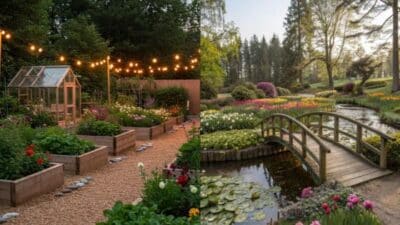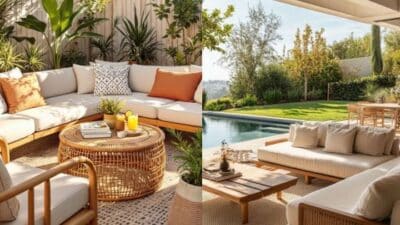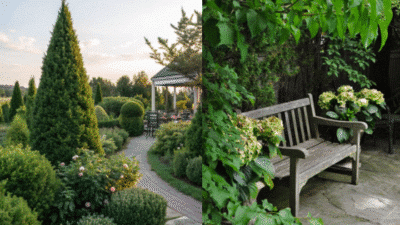A pergola with seating offers a comfortable and stylish way to enjoy your outdoor space while providing a designated area to relax or entertain. By combining shelter and built-in seating, you create a functional hub for conversation, dining, and leisure in your backyard. Pergolas can be designed with a variety of materials and seating options—from integrated benches to cozy swings—to suit your space and needs.
You’ll find that a pergola with seating not only boosts the visual appeal of your yard but also increases its usability. Whether you prefer a modern metal design or classic wooden look, thoughtful selection of materials and features ensures your new space fits your outdoor lifestyle perfectly.
Key Takeaways
- Pergolas with seating enhance both comfort and functionality outdoors
- Design and material choices impact style, use, and enjoyment
- Careful planning helps you maximize your outdoor living area


Key Elements of a Pergola With Seating
Selecting the right pergola with seating depends on the intended use, available space, and material preferences. Consideration should be given to the type of pergola, how seating is incorporated, and how privacy and shade are balanced.
Types of Pergolas
A pergola can be freestanding or attached to your home. Freestanding models are popular for defining a separate seating area anywhere in the yard. Attached pergolas connect directly to the exterior wall, extending your living space and often making access easier.
Materials are an important consideration:
- Wooden pergolas provide a classic look. Cedar and redwood are common due to their durability outdoors.
- Metal pergolas, made from aluminum or steel, offer modern aesthetics and require less maintenance.
When choosing your pergola type, think about the permanence you desire, maintenance level, and how it will interact with your garden or patio.
Integrated and Modular Seating Options
Built-in seating, such as benches along the perimeter of the pergola, maximizes available space and creates a cohesive look. Modular seating options, like movable sofas or sectional sets, offer flexibility to change the arrangement as needed.
Compare the Options:
| Seating Type | Pros | Cons |
|---|---|---|
| Built-in Benches | Space-saving, sturdy, cohesive design | Less flexible, permanent layout |
| Modular Sofas | Flexible, easy to rearrange | May require more space, less tidy |
Add cushions, weather-resistant fabrics, and low tables for comfort. Choose seating that fits the dimensions of your pergola to avoid overcrowding and leave enough room for easy movement.
Shade and Privacy Considerations
Effective pergola designs provide both shade and privacy, making your outdoor seating area comfortable and inviting. Use a combination of fixed and adjustable elements:
- Retractable canopies or shade sails let you control sunlight exposure.
- Latticework, climbing plants, or outdoor curtains add privacy and soften the structure.
Material choice also affects shade. Wooden slats with close spacing increase shade, while metal frames can support fabric drapes or panels. If privacy is a concern, consider growing tall shrubs or installing slatted screens around the seating area. This helps create a secluded, relaxing retreat.


Design Inspirations for Pergolas With Seating
Designing a pergola with seating offers a way to expand your usable outdoor space for relaxation or entertaining. Whether you want sleek minimalism, rustic coziness, lush greenery, or a compact solution, you can find a style that fits your backyard and seating preferences.
Modern Pergola and Minimalist Seating
A modern pergola often features clean lines, neutral colors, and simple construction materials like steel, aluminum, or painted wood. For seating, low-profile modular sofas or benches in monochrome shades work well. Incorporate materials such as weatherproof cushions in gray or beige tones, and opt for geometric coffee tables in concrete or metal.
Open, uncluttered layouts help maintain a minimalist feel. Use hidden LED lighting strips under cross-beams to create subtle illumination for evening use. Skip excessive decorations and let the quality of design and materials stand out.
You might also include a small row of potted plants, choosing species with architectural shapes like snake plants or succulents for a modern touch. Privacy screens in frosted glass or slatted wood can add separation without disrupting sightlines.
Rustic Backyard Pergola Ideas
For a rustic approach, select a pergola design built from natural materials such as cedar, redwood, or reclaimed lumber. Exposed beams, rough-hewn posts, and earthy finishes create a relaxed, welcoming impression. Furniture should include weathered wooden benches, Adirondack chairs, or swings with thick, colorful cushions.
Accent the seating area with blankets, woven baskets, and lantern-style lighting. Brick or flagstone flooring enhances the rustic charm.
Pair your rustic pergola with plenty of greenery. Line the base with decorative grasses or trailing ground covers, and scatter large terracotta planters filled with herbs and perennials. If you have a large pergola, integrate a built-in stone fireplace or fire pit for additional warmth and socializing opportunities.
Creative Use of Climbing Plants and Greenery
Climbing plants like wisteria, grapevines, or clematis add privacy and beauty to your garden pergola. Train these vines along the posts and cross-beams to create living shade overhead. Choose fast-growing species for quicker results, or mix flowering and evergreen varieties for year-round interest.
Place built-in or moveable benches beneath the pergola and add a scattering of weather-resistant cushions. Enhance the sense of enclosure by grouping additional potted plants around seat edges. This will soften hard lines and increase visual appeal.
For smaller pergolas or patios, use hanging baskets filled with trailing plants to maximize available space. Keep seating unobtrusive to ensure greenery remains the focal point. Create color contrast by selecting vibrant plantings to complement or offset seating fabrics.
Small Pergola Solutions
A small pergola can dramatically improve a compact yard or garden. For limited spaces, look for wall-mounted or corner pergola designs that maximize available area without overwhelming your property. Foldable bistro sets or slim modular benches work well, providing comfortable seating without clutter.
Use vertical gardening solutions like trellis panels or hanging planters to introduce greenery. Select climbing vines such as jasmine or sweet pea for vertical coverage that doesn’t encroach on usable floor space.
Lighting should remain subtle, with solar-powered string lights or low-profile lanterns to prevent overcrowding the area. To achieve a sense of openness, maintain a simple color palette and resist the urge to overdecorate. With careful planning, even a small pergola can become a welcoming, functional retreat.


Materials and Construction Approaches
Choosing the right materials and construction method for your pergola with seating affects its longevity, appearance, and how involved your installation will be. Different materials also impact maintenance needs and resilience to weather.
Wood Pergola Options and Staining
Wood pergolas are a classic choice for outdoor spaces, offering a natural look that fits many landscaping styles.
Cedar wood is especially popular due to its natural resistance to rot and insects. Other commonly used woods include redwood and pressure-treated pine. When choosing wood, consider the local climate—some woods fare better in moist or sunny conditions.
Staining your pergola is useful for preserving wood and enhancing its color. Oil-based stains help protect against UV damage and moisture. Regular maintenance, such as resealing every 2-3 years, keeps the pergola looking fresh.
Lumber sizes like 4x4s for columns and 2x8s or 2x10s for beams and rafters are common. Using quality fasteners and brackets ensures stability, which is important if your pergola will support seating structures.
Metal and Galvanized Steel Pergolas
Metal pergolas provide strength and a modern appearance. Galvanized steel is a common material for these pergolas, offering durability and strong resistance to rust.
Powder-coated finishes add an extra layer of protection against the elements and offer more color options. Metal pergolas often use square or round columns for support. Installation may require concrete footings due to the heavier weight compared to wood.
A comparison of common metal options:
| Material | Advantages | Considerations |
|---|---|---|
| Galvanized Steel | Durable, low maintenance | Heavier, higher cost |
| Iron | Classic look, strong | Requires coatings |
| Aluminum | Lightweight, rustproof | Less strong for large spans |
Metal pergolas work well with integrated seating, especially benches with built-in storage, due to their high load capacity.
Ready-to-Assemble and Pergola Kits
Ready-to-assemble pergola kits simplify the construction process with pre-cut, labeled components and detailed instructions. These kits are available in both wood and metal materials.
You can choose from a range of standard sizes or opt for a custom pergola kit to fit unique spaces. Kits typically include pre-drilled columns, beams, rafters, and all fasteners required for assembly.
Assembly can often be completed in a weekend using common household tools such as drills, wrenches, and levels. Some kits even integrate options for attached seating, making it easier to coordinate your structure and furnishings.
Buying a kit can be cost-effective but still allows you to personalize with stain, paint, or decorative brackets. Always check the kit specifications to ensure compatibility with your site and anchoring requirements.


Enhancing Outdoor Living With Pergola Seating
Adding seating to your pergola elevates your outdoor living by making it more functional and comfortable. Thoughtful choices in design, furniture, and decor create an inviting environment for relaxing or hosting guests.
Creating Cozy Seating Areas
A cozy seating area under a pergola can begin with selecting weather-resistant outdoor furniture. Wicker sofas and cushioned chairs are practical and provide comfort for long conversations or quiet reading in the shade.
You can use outdoor curtains to introduce privacy and shelter from sun or breeze. Pillows and throws add softness and color, while hanging baskets with trailing plants make the space feel lush and welcoming.
Key considerations:
- Use modular furniture for flexibility.
- Opt for easy-care fabrics.
- Include a small side table for drinks or books.
Arranging the furniture to face inward encourages conversation and a shared experience. Layering textures and greenery helps the space feel intimate.
Incorporating Dining and Entertaining Spaces
If you enjoy alfresco meals, integrating a dining area beneath your pergola extends your living space outdoors. Choose a weather-resistant dining table and chairs sized to fit your pergola’s dimensions without overcrowding.
Bench seating can serve double duty—as additional seating for gatherings or as storage for outdoor essentials. Consider a bar cart nearby for added convenience during get-togethers.
Table: Dining Essentials Checklist
| Item | Details |
|---|---|
| Dining Table | Weatherproof materials |
| Chairs/Benches | Stackable or cushioned |
| Outdoor Serveware | Durable, washable |
| Shade Solution | Umbrella or curtains |
Keep walkways clear and leave enough space to move comfortably around the table when it’s in use.
Lighting and Ambience With String Lights
Proper lighting transforms your pergola seating area after dark. String lights are a popular choice for their warm, diffuse glow—inexpensive yet effective at enhancing ambience.
You can drape string lights overhead, weave them along rafters, or wrap posts for a layered effect. Combine with lanterns or solar stake lights for both general and task lighting.
To boost coziness, choose warm white bulbs and consider dimmable options. Lights with weatherproof ratings ensure they hold up against the elements, making your outdoor living area usable and enjoyable well into the evening.


Functional Features and Outdoor Amenities
Adding functional features and amenities to your pergola with seating can maximize comfort, enhance usability, and increase property value. Thoughtful integration of elements like a fire pit, outdoor kitchen, or privacy screens can transform a basic seating pergola into a versatile outdoor retreat.
Poolside and Hot Tub Integration
Integrating a pergola with your poolside or hot tub area creates a comfortable, shaded space near the water. A pergola adjacent to a pool provides a designated place for relaxation after swimming and makes it easy to keep an eye on children or guests. Built-in seating under the pergola offers a quick spot to dry off or enjoy a beverage.
Consider water-resistant seating materials for durability. Tile, stone, or composite decking work well in damp areas. You might add towel storage or hooks for swimwear to keep the space organized. Proper drainage is important to prevent excess moisture buildup around the seating.
A poolside pergola can include subtle lighting for evening use. If your hot tub is covered by the pergola, a retractable canopy or curtains can offer privacy while still allowing airflow.
Adding a Fire Pit or Outdoor Fireplace
A fire pit or outdoor fireplace can extend the usability of your pergola throughout the cooler months. With built-in seating arranged around a central fire feature, you create a cozy atmosphere for gathering and conversation.
Gas fire pits are low maintenance and can be controlled with a switch, while wood-burning models offer a traditional campfire feel. When selecting a location for your fire feature, maintain safe distances from flammable surfaces and choose fire-resistant building materials for the seating and flooring.
An outdoor fireplace against one end of the pergola can also act as a windbreak. Example seating layouts include a U-shape or semicircle to ensure everyone enjoys warmth from the flames.
Barbecue and Outdoor Kitchen Setups
Adding an outdoor kitchen or barbecue station to your pergola turns your seating area into a functional space for dining and entertaining. Key features often include a built-in grill, counter space for food prep, and storage cabinets for utensils and supplies.
Consider integrating a small fridge or sink for convenience. Arrange the seating to allow guests to interact with the cook without overcrowding the prep area. Stone or concrete countertops are durable choices that withstand outdoor conditions.
You can use a bar-height counter with stools as part of your seating design. If space is limited, a compact built-in barbecue flanked by benches maximizes efficiency while providing a social hub during gatherings.
Privacy Screens and Landscaping
Privacy screens enhance the sense of seclusion and shield your pergola seating from neighboring views. Materials such as horizontal wood slats, lattice panels, or outdoor curtains are common choices.
Landscaping further boosts privacy and aesthetic appeal. Hedges, tall grasses, or climbing vines can soften the lines of the structure and provide natural shade. Choose plants suited to your local climate for ease of maintenance.
Consider layering different heights of plants for a lush look. Adding potted trees or vertical gardens not only creates a green backdrop but can also help block wind and noise, making your seating area more enjoyable year-round.


Planning, Building, and Placement Tips
A well-designed pergola with seating adds both function and style to your outdoor living space. Thoughtful placement, deck or patio integration, and your choice between DIY and professional installation impact the final results.
Selecting the Right Location
Choose a location in your backyard that maximizes shade, accessibility, and views. Avoid areas that block key pathways or interfere with garden features like prized plants or a vegetable patch. Consider wind direction, sunlight patterns, and proximity to your home when deciding on placement.
If you want your pergola to cover a dining or lounge area, measure the space to ensure you have adequate room for seating, tables, and movement. Privacy matters—use the structure to screen out neighbors or street views if preferred. Local building codes may influence where you can set up structurally, so check any required permits or setback rules.
Deck and Patio Integration
For a deck design, integrating a pergola requires secure attachment to existing posts or framing. Use weather-resistant fasteners and ensure the structure can handle both weight and wind loads. If your patio is concrete or pavers, anchor the posts firmly with suitable brackets or post anchors for stability.
Popular integration ideas include:
- Built-in bench or sectional seating along the pergola sides
- Planter boxes around the base or at the end for an arbor-like feel
- Lighting and ceiling fans mounted to overhead beams
A patio pergola can provide defined zones for different functions, such as grilling, dining, or relaxing. When combined with outdoor seating, your backyard discovery becomes a practical gathering spot year-round.
DIY vs. Professional Installation
Building a pergola yourself appeals if you have construction skills and want to customize every aspect. DIY kits simplify the process and often include pre-cut lumber and hardware. Assembly usually takes a weekend for a basic build, but integrating seating adds time.
Hiring a professional ensures proper footing, stability, and compliance with all local codes. Custom features, such as complex arbor shapes or unique seating arrangements, are easier to achieve with contractor expertise. Consider your budget, time, and desired finish before choosing your approach.
- 1.0Kshares
- Facebook0
- Pinterest1.0K
- Twitter0



